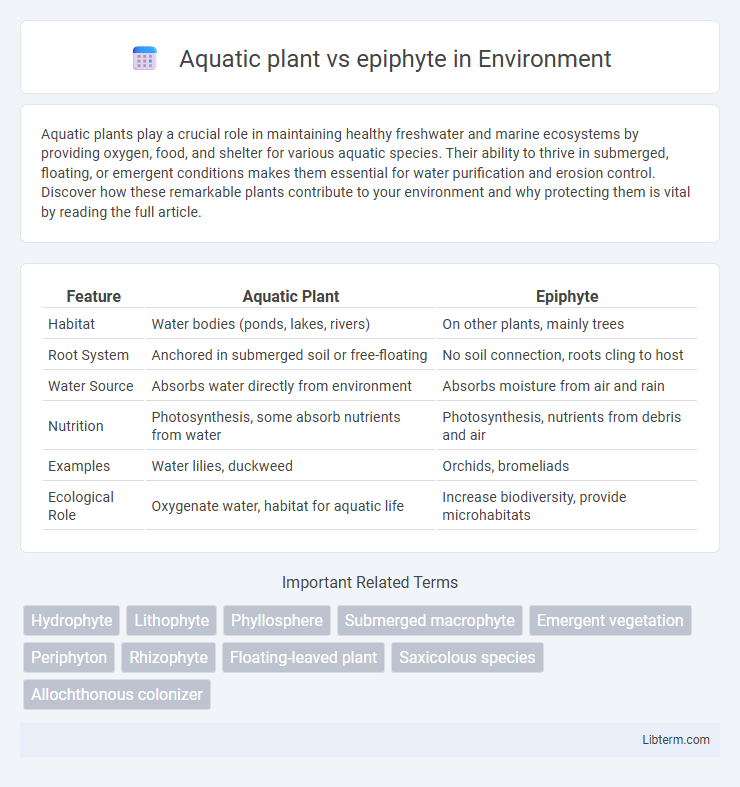Aquatic plants play a crucial role in maintaining healthy freshwater and marine ecosystems by providing oxygen, food, and shelter for various aquatic species. Their ability to thrive in submerged, floating, or emergent conditions makes them essential for water purification and erosion control. Discover how these remarkable plants contribute to your environment and why protecting them is vital by reading the full article.
Table of Comparison
| Feature | Aquatic Plant | Epiphyte |
|---|---|---|
| Habitat | Water bodies (ponds, lakes, rivers) | On other plants, mainly trees |
| Root System | Anchored in submerged soil or free-floating | No soil connection, roots cling to host |
| Water Source | Absorbs water directly from environment | Absorbs moisture from air and rain |
| Nutrition | Photosynthesis, some absorb nutrients from water | Photosynthesis, nutrients from debris and air |
| Examples | Water lilies, duckweed | Orchids, bromeliads |
| Ecological Role | Oxygenate water, habitat for aquatic life | Increase biodiversity, provide microhabitats |
Introduction to Aquatic Plants and Epiphytes
Aquatic plants, also known as hydrophytes, thrive in water-rich environments such as ponds, lakes, and wetlands, playing crucial roles in oxygen production and habitat formation. Epiphytes grow non-parasitically on other plants, particularly trees, deriving moisture and nutrients from the air and rain, and contributing to biodiversity within forest ecosystems. Understanding the distinct adaptations of aquatic plants and epiphytes reveals their ecological importance and specialized survival strategies.
Defining Aquatic Plants
Aquatic plants are specialized organisms that thrive either fully submerged or partially in water, with adaptations such as buoyant leaves and flexible stems to survive aquatic environments. Unlike epiphytes, which grow on other plants without soil, aquatic plants root in water or sediment, obtaining nutrients directly from their watery surroundings. Key examples include water lilies, cattails, and pondweeds, which play vital roles in aquatic ecosystems by providing oxygen and habitat for wildlife.
Understanding Epiphytes
Epiphytes are plants that grow non-parasitically upon other plants, deriving moisture and nutrients from the air, rain, and debris accumulating around them rather than from soil. Unlike aquatic plants that thrive submerged or floating in water environments, epiphytes adapt to terrestrial habitats such as tree branches in tropical rainforests. Understanding epiphytes reveals their specialized roots and leaf structures designed for water absorption and nutrient uptake in nutrient-poor environments, highlighting their ecological role in biodiversity and habitat complexity.
Habitat and Distribution Differences
Aquatic plants thrive in water-rich environments such as lakes, ponds, and slow-moving rivers, where their roots are submerged or floating in water. Epiphytes grow non-parasitically on other plants, mainly trees, in humid environments like tropical rainforests, deriving moisture and nutrients from the air and debris. The habitat distribution of aquatic plants is confined to aquatic ecosystems, whereas epiphytes are widespread in terrestrial ecosystems, especially in tropical and subtropical regions.
Morphological Adaptations
Aquatic plants exhibit morphological adaptations such as flexible stems, aerenchyma tissues for buoyancy, and reduced or absent cuticles to facilitate gas exchange in water. Epiphytes develop specialized root structures called velamen to absorb moisture and nutrients from the air, and often possess thick, waxy leaves to minimize water loss in aerial environments. Both plant types have evolved distinct structural features to optimize survival in their unique habitats.
Nutrient Acquisition Strategies
Aquatic plants absorb nutrients directly from the water through their roots and leaves, adapting to variable nutrient availability in submerged environments. Epiphytes obtain nutrients primarily from organic debris, rainwater, and atmospheric deposition while anchored to host plants, relying on specialized root structures to capture these resources efficiently. Both strategies highlight unique adaptations to maximize nutrient uptake in distinct ecological niches.
Reproduction and Lifecycles
Aquatic plants reproduce through seeds, spores, or vegetative means such as runners and tubers, adapting their lifecycles to submerged or floating environments with water facilitating pollination and seed dispersal. Epiphytes reproduce via spores or seeds dispersed by wind or animals, with lifecycles closely tied to their host plants, relying on moisture from the air and organic debris for nutrient acquisition. Both strategies highlight specialized adaptations to their distinct habitats, with aquatic plants often having lifecycle stages fully submerged, while epiphytes complete growth and reproduction entirely above ground on host surfaces.
Ecological Roles in Their Environments
Aquatic plants play a crucial role in aquatic ecosystems by oxygenating water, stabilizing sediment, and providing habitat for fish and invertebrates. Epiphytes, which grow on other plants without harming them, enhance biodiversity by creating microhabitats and contributing to nutrient cycling in forest canopies. Both plant types support ecological balance, with aquatic plants influencing water quality and epiphytes fostering vertical stratification in terrestrial environments.
Human Uses and Benefits
Aquatic plants provide essential ecosystem services such as water purification and habitat creation, supporting fisheries and serving as food sources like watercress and lotus. Epiphytes, including orchids and bromeliads, contribute to biodiversity and are prized in horticulture for ornamental uses, while some species have medicinal properties and help improve air quality indoors. Both plant types enhance ecological balance and offer economic benefits through agriculture, landscaping, and natural product industries.
Key Differences: Aquatic Plants vs Epiphytes
Aquatic plants grow rooted or free-floating in water bodies, thriving in submerged or partially submerged environments with adaptations like aerenchyma for buoyancy and gas exchange. Epiphytes grow non-parasitically on other plants, mainly trees, deriving moisture and nutrients from air, rain, and debris rather than soil, showcasing adaptations such as specialized root structures for anchorage and water absorption. The primary difference lies in their habitat variability: aquatic plants depend on water-saturated environments, while epiphytes inhabit aerial niches above ground level.
Aquatic plant Infographic

 libterm.com
libterm.com